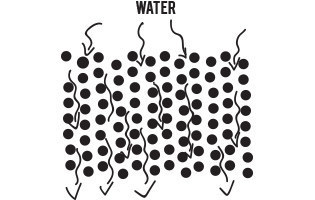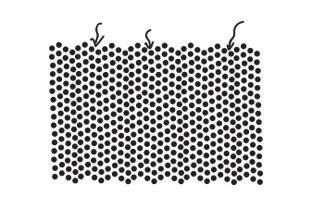Espresso
Dialling in espresso is certainly not something you learn overnight and it takes some time to fully understand the complexity of coffee extraction in espresso. Espresso can thus quickly become a frustration if you don't understand the principles and it's important to be aware of that before investing in expensive equipment. At the other hand, the complexity and the continuous learning curve in espresso makes it super exciting, especially when tasting that perfect cup of gold you just made!
In this article we will give you our personal recipe to pull a shot of espresso, but if you're interested in understanding the science of extraction, setting up your grinder or how to influence the taste of your espresso, we recommend checking out our Barista workshops.
Grind size and extraction
Grind size is one of the key elements for good extraction. The surface area of your ground coffee defines how much you extract from each coffee particle and so the finer and finer you grind, the more you increase the extraction. This means that finding the right grind size is key.
If you grind too coarse, you risk underextraction, leading to watery and sour flavours in the cup. Too fine, however, and you might end up with overextracted espresso. The optimum brew time for a shot of espresso is somewhere between 25 and 30 seconds, so you don’t have much margin for error.
Grind size is the first variable a home barista should consider when dialling in espresso. Adjusting your grinder is an important part of a Barista’s daily routine. Adjusting daily or even hourly may be necessary depending on the weather inside and outside your cafe.
Coarse vs fine
As the temperature, humidity, and barometric pressure changes, you will need to adjust your grind size. If your shot times are too slow or too fast, there's a good possibility the grind of the coffee is either too coarse (time too short) or too fine (time too long).
Coarse - Think of the coarse like you think of a jar of stones. The larger the marbles in the jar, the faster water can pass through. When you make coffee more coarse - more water will also pass through the coffee quickly. If your espresso or brew is too long, a coarser grind is what you are looking for.

Fine - Think of a finer grind as you would think of a jar of sand. The smaller the sand particles, the slower water will pass through the jar. When you make coffee more fine, water will pass through the coffee more slowly. If your espresso or brew is too short, a finer grind is what you are looking for.

What coffee for espresso?
It's important to use a freshly roasted coffee, roasted specifically for espresso. Always check the roast date on your bag as well as the information about roast profile. Coffee for espresso is at its best 2 weeks after roast date. Find all our espresso coffees here.
What you'll need (for a double shot)
Coffee grinder (with burrs)
Your favourite whole beans coffee
A good quality espresso machine with portafilter
Tamp tool
Scale
Timer
Brew time: 25-30 seconds
Ratio: 18g of coffee for 36g of water (1:2)
Water: use soft water (50-80ppm) or add a water filter to your espresso machine.
Target TDS: 8.0 - 9.5
Step 1: Grind 18 grams (for a double shot) at a fine espresso grind setting in the portafilter.
Step 2: Distribute the coffee evenly in your portafilter and tamp level without putting too much pressure.
Step 3: Flush the grouphead quickly and lock your portafilter.
Step 4: Press the double espresso button and start the timer at the same time.
Step 5: The liquid inside the cup should be approximately 2 times the weight of the ground coffee. Using 18 grams of ground coffee at a ratio of 1:2 will be 36 grams of liquid in the cup.
Step 6: Target a brew time between 25 to 30 seconds. If it flows too fast, grind your beans finer ; if it flows too slowly, grind your beans coarser.
Step 6: Don't forget to flush again and clean your portafilter right after using it.
Tip: we use small pitchers to easily create our different coffee recipes (e.g cappuccino, doppio or flat white). Each pitcher represents one shot of espresso (9g) and can be used together or separately.
